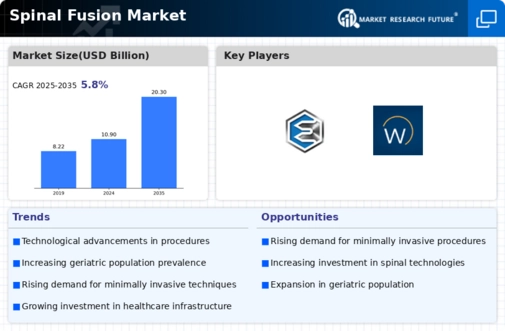Leading market players are investing heavily in research and development to expand their product lines, which will help the Spinal Fusion market, grow even more. Market participants are also undertaking a variety of strategic activities to expand their footprint, with important market developments including new product launches, contractual agreements, mergers and acquisitions, higher investments, and collaboration with other organizations. To expand and survive in a more competitive and rising market climate, the Spinal Fusion industry must offer cost-effective items.
Manufacturing locally to minimize operational costs is one of the key business tactics used by manufacturers in the Spinal Fusion industry to benefit clients and increase the market sector. In recent years, the Spinal Fusion industry has offered some of the most significant advantages to patients suffering from spinal disorders and practitioners conducting spinal surgeries.
Major players in the Spinal Fusion Market, including Zimmer Biomet Holdings, Inc., Stryker Corporation, Inc., Exactech, Inc., Medtronic Plc, Johnson & Johnson Services, Inc (Depuy Synthes), Wenzel Spine, Inc., Centinel Spine, Inc., Spineart Geneva SA, K2M, Inc., MicroPort Scientific Corporation are attempting to increase market demand by investing in research and development operations.
Johnson & Johnson (J&J) is engaged in the research, development, manufacturing, and sale of pharmaceutical products, medical devices, and consumer goods. The company offers a range of pharmaceuticals addressing immune diseases, cancer, neurological disorders, infectious diseases, cardiovascular issues, and metabolic conditions. In addition, J&J provides consumer products spanning oral care, baby care, beauty, over-the-counter (OTC) medicines, women's health, and wound care. Their medical devices cover cardiovascular, orthopedic, neurovascular care, general surgery, and vision care. J&J distributes pharmaceutical and medical products to retailers, wholesalers, healthcare professionals, and hospitals. Consumer products are made available through retail outlets and distributors.
The company operates in regions including the US, Europe, Asia-Pacific, Africa, and the Western Hemisphere (excluding the US), with its headquarters located in New Brunswick, New Jersey, USA. In a strategic move announced in September 2018, Johnson & Johnson Medical Devices Companies completed the acquisition of Emerging Implant Technologies GmbH (EIT). This acquisition aims to enhance J&J's portfolio in both minimally invasive and open spinal fusion surgery. The primary objective is to offer a wider range of interbody solutions to surgeons, empowering them to deliver improved treatment options for patients.
Medtronic Plc (formerly Medtronic Inc.) is a leading medical technology company specializing in the design, development, manufacturing, and marketing of medical devices and solutions. The company's product range encompasses treatments for heart valve disorders, heart failure, coronary artery diseases, aortic, peripheral vascular, venous renal, and neurological diseases, as well as spine and musculoskeletal disorders. Additionally, Medtronic addresses diseases of the ear, nose, and throat, and provides biologic solutions for the orthopedic and dental markets.
Medtronic serves a diverse customer base, including hospitals, third-party healthcare providers, clinics, governmental healthcare programs, distributors, and group purchasing organizations across Asia Pacific, Europe, the Americas, the Middle East, and Africa. With its headquarters in Dublin, Ireland, Medtronic is actively involved in acquisitions, alongside companies like Stryker Corporation, as part of its strategic initiatives to enhance its position in the spine market. This approach aims to improve their product portfolios and presence.













